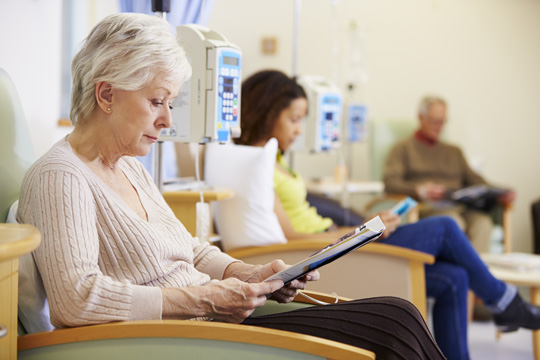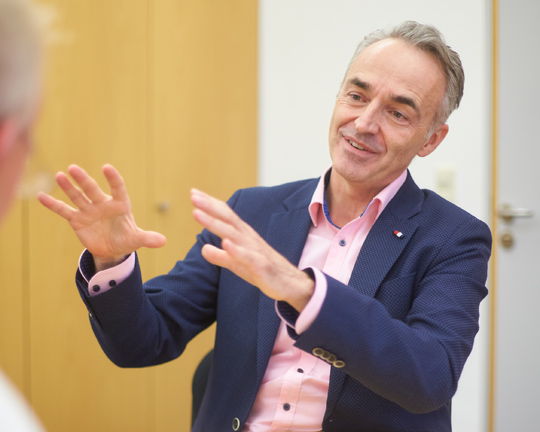Barriers to Healing
Freiburg, Dec 19, 2019
Are innovative medicines getting stuck in development? The League of European Research Universities (LERU) complains of difficulties in research into Advanced Therapy Medicinal Products (ATMPs) and their use. Prof. Dr. Toni Cathomen is working on these ATMPs, innovative medicines, at the University Medical Center Freiburg. The director of the Institute for Transfusion Medicine and Gene Therapy (ITG) fears that German universities and university hospitals are unable to progress with ATMPs. In interview with Jürgen Schickinger, Cathomen explains what ATMPs and the LERU initiative are about.

Toni Cathomen believes university hospitals offer the ideal framework for the development and application of innovative medicines. Photo: Monkey Business/stock.adobe.com
Professor Cathomen, what exactly are ATMPs?
Toni Cathomen: It’s a group of new medicines for “innovative” or “advanced” therapies, as their name implies. ATMPs are “living medicines”, often the cells of a patient. Researchers modify these cells massively for medical application. In the hospital, doctors use them as gene therapeutics, somatic cell therapeutics and biotechnologically-processed tissue products.
Can you name a few real-life examples?
CAR T-cells are currently in vogue for the treatment of certain types of leukemia. These are immune cells with chimeric antigen receptors, “CAR” for short. They’re composed of receptor parts with different origins. Scientists extract the T-cells from cancer patients and replace them with CARs, so that with the aid of the CARs the immune cells recognize the tumor cells as “foreign”. So the patient’s immune system launches a defensive reaction to fight the tumor. Receptors can similarly be removed from the blood stem cells that create immune cells – for example the receptor that the Human Immunodeficiency Virus (HIV) uses to infect immune cells. Without this receptor the immune system is resistant to HIV. A third example is replacement tissue made from the patient’s own cells, such as new cornea for people who have burned their eyes.
Therapies like this are already being used on patients?
Yes, many are – including here at the Freiburg University Medical Center. In total almost twenty ATMPs are already licensed in Europe. In our cancer center for instance we are using CAR T-cells. My department is developing CAR T-cells that can fight solid tumors like prostate cancer. We’re also working on stem-cell therapies for children who are suffering from congenital immune disorders, and are preparing for a clinical trial with HIV patients. We want to heal them by replacing their immune system with one where the cells lack the aforementioned receptor for HIV.
So how effective is this work?
It’s definitely positive. The tumor patients who received the CAR T-cells were already deemed incurable, that is, all the routine treatment options had been exhausted. They probably only had two to three months to live. After treatment with CAR T-cells more than fifty percent have survived to date and are largely tumor-free. That’s remarkable – ATMPs are a success story.
All the same, according to LERU there are a lot of barriers to development.
Yes, one of the largest is in infrastructure: in order to produce ATMPs we need clean rooms – rather like those for the production of microchips. But in some cases they don’t yet exist. Here at the Freiburg University Medical Center there are plans for a clean room center, which would be used by three departments: the hospital pharmacy, nuclear medicine, and us, developing ATMPs. We also need national or pan-regional centers in order to combine ATMP research better, such as is planned in the LERU initiative.

“ATMPs are a success story,” says Toni Cathomen – the medicines are being used in the treatment of cancer, HIV and many hereditary and infective diseases, for instance. Photo: Harald Neumann
LERU also criticizes political barriers – what form do they take?
Research, production and clinical trials with ATMPs are strictly regulated in Europe. That’s good for patient safety, but in Germany in particular the regulatory barriers are so high that ATMP researchers from other countries avoid us. In addition the federal system makes our work more difficult. Nationally the Paul Ehrlich Institution is responsible for approving clinical trials with ATMPs, but the federal states are responsible for production. Each has their own rules and responsibilities, and these are often spread across several regional councils: we have to deal with many authorities for a clinical trial. It gives rise to meters and meters of correspondence files.
Is it easier elsewhere?
They handle it well in the UK. There, they’ve put a lot of money into central national institutions that help academic institutions and biotechnology companies to bring ATMPs to patients. In addition the regulatory barriers in the UK aren’t as high. But they still emphasize security. France and Italy by contrast combine their ATMP research in just a few centers. For Germany to be competitive again, regulatory barriers will have to be reduced and simplified drastically. The cost of academic studies with ATMPs is disproportionately high in our country.
Why does LERU also complain about poor career opportunities?
Scientists who work with ATMPs often need many years to publish something, because of the long development time. But in academia if you don’t publish for a long time, you’ve failed. So we need different solutions and other employment models: after twelve years the German Higher Education Framework Act doesn’t permit further employment. That’s unrealistic. We need well-educated basic staff in ATMP development and suitable jobs in mid-level academic positions. So we’re hoping for more support from the federal state. It’s not enough simply to put up buildings.
Can the hospitals improve a bit too?
Yes, we should integrate ATMPs more in clinical training. Doctors have to learn what ATMPs there are, what they can do and what new ATMPs may be able to achieve. So joint projects are being developed. Because university hospitals in particular are predestined for ATMP development: they combine clinical, technical and regulatory expertise under one roof. And the patients are also there. However clinical trials are very expensive. The public sector can contribute to the costs, but it can’t bear them alone. We’ll have to reach compromises here ourselves, set up cooperations with industry and share the commercial earnings from our developments.
So do you see further potential in ATMPs?
There are infinite possibilities, particularly in regenerative medicine which treats cells, tissue or organs after accidents, diseases and aging. At our Orthopedics and Trauma Surgery clinic, for example, colleagues take cartilage cells from their patients, reproduce them and inject them into the patient’s knee, to repair damage there. And ATMPs will help many patients in future too for many hereditary or infective diseases such as Hepatitis B.
LERU’s ATMP initiative
The League of European Research Universities (LERU) believes there are major barriers to bringing Advanced Therapy Medicinal Products (ATMPs) to patients, and has published a position paper on this. In it, it calls amongst other things for improving cooperation between all those involved, from the universities through the authorities to industry. Authorities should reduce or amend certain regulations so as to increase transparency in the development of ATMPs, in order that research groups can build on the results of other scientists more easily. This is expected to boost progress in this field. And with the same goal in mind, LERU is also calling for research on ATMPs to be networked and combined more. Finally, new paths should be opened up to ATMP researchers offering greater career opportunities at universities.
Read the position paper

